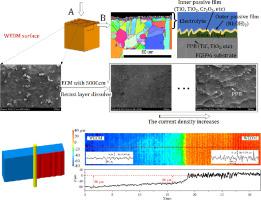Electrochimica Acta ( IF 5.5 ) Pub Date : 2022-04-11 , DOI: 10.1016/j.electacta.2022.140372 Zhao Han 1 , Xiaolong Fang 1 , Yongbin Zeng 1 , Di Zhu 1

|
Surface integrity has an important impact on the fatigue life of aero-engine parts, especially the recast layer formed by electrical discharge machining. Wire electrochemical trimming is a method to remove the recast layer (WECT) by utilizing a wire electrode that sweeps along the surface to remove material through an electrochemical reaction, which can ensure the requirements of accuracy and surface integrity simultaneously. An electric-field model was established to investigate current distributions in the WECT machining zone. The results indicated that when the wire electrode sweeps the surface, to accomplish high-precision WECT, it is essential to control three stages including rapid breakdown of the passive film, complete dissolution of the recast layer, and diminishment of overcut of stray current. To this end, the microstructure and polarization behavior of the René 88DT recast layer was first studied and the breakdown behavior of its passive film was analyzed. Results indicate that the crystallite size of recast layer is far less than that of the substrate, and the passive film of recast layer is more difficult to dissolve. Passive film models were established, revealing that the surface of the recast layer adheres to a loose outer passive film (Ni(OH)2) and a dense inner passive film (TiO, TiO2, Cr2O3). The experimental results were then used to derive the critical conditions for the dissolution of the recast layer: when the current density i > 2 A.cm−2, the recast layer starts to dissolve, and when the electric quantity Q = 500 C.cm−2, the recast layer is completely removed. Finally, the preferred parameters were selected by the critical conditions, and the wire electrical discharge machining surface was trimmed to a smooth surface without a recast layer. This paper is expected to provide research ideas for future high-precision electrochemical fabrication of aero-engine applications.
中文翻译:

用于航空发动机应用的 René 88DT 上的金属丝电化学修整重铸层
表面完整性对航空发动机零件的疲劳寿命有重要影响,尤其是电火花加工形成的重铸层。线材电化学修整是利用沿表面扫过的线电极通过电化学反应去除材料的一种去除重铸层(WECT)的方法,可以同时保证精度和表面完整性的要求。建立了一个电场模型来研究 WECT 加工区的电流分布。结果表明,当线电极扫过表面时,要实现高精度的WECT,必须控制钝化膜的快速击穿、重铸层的完全溶解和杂散电流过切的减少三个阶段。为此,首先研究了René 88DT重铸层的微观结构和极化行为,并分析了其钝化膜的击穿行为。结果表明,重铸层的微晶尺寸远小于基体,重铸层的钝化膜更难溶解。建立了钝化膜模型,揭示了重铸层的表面粘附在松散的外部钝化膜(Ni(OH)2 ) 和致密的内部钝化膜 (TiO, TiO 2 , Cr 2 O 3 )。然后利用实验结果推导出重铸层溶解的临界条件:当电流密度i > 2 A.cm -2时,重铸层开始溶解,当电量Q = 500 C.cm -2,重铸层被完全去除。最后,根据临界条件选择优选参数,将线放电加工表面修整为无重铸层的光滑表面。该论文有望为未来高精度电化学制造航空发动机应用提供研究思路。















































 京公网安备 11010802027423号
京公网安备 11010802027423号